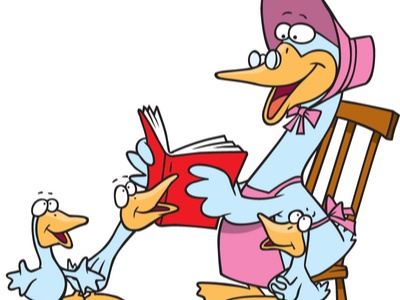Gamers are often fascinated by nursery rhymes whose rhythm, cadence and seemingly light-hearted themes resonate with slots gaming. Some nursery rhymes even serve as subject matter for whimsical online casino real money slots games. Some nursery rhymes are, in fact, simple and guileless but most people are unaware that many nursery rhymes have dark histories. Sloto Cash Casino invites slots aficionados and other interested parties to join us as we explore the history of some of the English-speaking world’s most beloved – and complex – nursery rhymes.
Nursery Rhyme History
English nursery rhymes date back to the 15th century when children sang “Pat-a-cake, pat-a-cake, baker’s man,” “to market, to market,” and “Cock a doodle doo” to pass the time. In the 18th century when childrens’ books began to be published, a number of new rhymes were introduced and old rhymes that had, until that time, been passed around orally, were recorded.
Tommy Thumb’s Song Book is thought to be the first English collection of nursery rhymes in 1744 and the genre started to be known as Mother Goose’s Nursery Rhymes soon afterward.
Historians believe that many of the nursery rhymes have hidden meanings. Some were anti-Catholic while others made fun of the monarchy, follies of the upper classes or specific persons in government office and historical events. .
Some well-known nursery rhymes with sad, unusual or curious histories include:
Three Blind Mice
The rhyme about three blind mice whose tails were cut off by the farmer’s wife’s carving knife is believed to refer to Queen Mary I whose reputation as “Bloody Mary” included may instances in which she hunted down and killed her enemies (or those who she believed to be her enemies).
Mary was a Catholic and was relentless in her efforts to bring Catholicism back to England. She is known for having burned almost 300 Protestant leaders at the stake (hence, her name “Bloody Mary”) In this case, Mary wanted to punish three Anglican bishops, who later became known as the “Oxford Martyrs” who refused to renounce Protestantism. Mary had them executed because they were “blind” in their Protestant beliefs.
Ring Around the Rosie
Ring Around the Rosie is probably one of the earliest rhymes that was adapted as a children’s game. In the 14th century the Black Plague tore through Europe, killing a huge percentage of the population. The Black Plague would appear as black sores on an infected person’s body and after infection, that person would almost certainly die (“ring around a rosy”).
People would stuff flowers – posies – into their pockets to cover the smell of decaying bodies that were piling up throughout the cities (“a pocket full of posies”). At some point, city leaders started to burn the bodies to keep the infection from spreading (“ashes, ashes, they all fall down").
London Bridge
There are a number of theories regarding when the London Bridge nursery rhyme appeared but it’s generally agreed that it’s another very early rhyme. Some historians believe that the destruction of London Bridge depicted in the song (“London Bridge is falling down”) refers to an attack on London by Olaf II of Norway in the early 11th century.
A second theory is that the song refers to children who were sacrificed and then buried in the bridge’s foundations, based on a myth that a bridge could collapse unless the body of a human sacrifice is buried in its foundations. Luckily, no archaeological evidence of human remains has ever been found in the bridge’s foundations.
Equally as puzzling is the line “my fair lady.” Who was that lady? Again, no one knows for sure but some suggestions put forward include Eleanor of Provence who owned the bridge from 1269-1281, Matilda of Scotland who consorted with Henry I or the Leigh Family whose family traditions include stories of human sacrifices buried below the bridge foundations.
Humpty Dumpty
Humpty Dumpty is another nursery rhyme of unknown origins. Some historians believe that it refers to King Richard III of England who fell off his horse at the Battle of Bosworth (1485, last significant battle of the War of the Roses) and was hacked to pieces by his enemies. Others say that it is more recent – from 1648 when it was the name given to a cannon used in the Siege of Colchester. The cannon was positioned on a wall and when the attacking side destroyed the wall, “Humpty Dumpty came tumbling down). A third version says that it was a simple child’s verse that referred to the average village idiot.
The vision of Humpty Dumpty as an egg comes from the reference to him in Lewis Carroll’s Through the Looking-Glass (1872). Carroll portrayed Humpty as a fussy egg-head who discusses the meaning of words and corrects Alice’s grammar.
Jack and Jill
Jack and Jill were long assumed to refer to Louis XVI and Queen Marie Antoinette of France. They were widely regarded as greedy and careless (“went up the hill”) who cared for little beyond filling their lives with the finest things in life. Both were beheaded during the French revolution (“came tumbling down”). Proponents of this theory show that the Jack and Jillnursery rhyme first appeared in 1795 which coincides with the events of the French revolution.
The connection to the king and queen of France is only one theory about the origins of this nursery rhyme. Other hypotheses include references to Richard Empson and Edmund Dudley who were executed in 1510 and to King Charles I of England who tried to raise money by reducing the amount of a Jack (1/8 pint) that was served in English pubs while maintaining the same tax.
Baa Baa Black Sheet
Baa Baa Black Sheep is one of the few nursery rhymes whose year of publication (1735) can be reasonably ascertained. However, its meaning is also shrouded in mystery. Some say that it refers to the slave trade of the Americas while others believe that it references England’s heavy wool tax.
Mary, Mary, Quite Contrary
Mary, Mary, Quite Contrary’s origins are not as disputed as those of other nursery rhymes. It’s well accepted that the rhyme about “Mary, Mary Quite Contrary” refers to Bloody Mary, Mary I of England who would stop at nothing to restore Roman Catholicism to England. Mary suffered numerous miscarriages throughout her life and both the lines “how does your garden grow?” and “pretty maids all in a row” could well refer to those dead babies.
Well... let's not end on a gruesome note....let's all head on over to the casino lobby and have some FUN! Shall we look for games based on nursery rhymes? Sure, why not?






